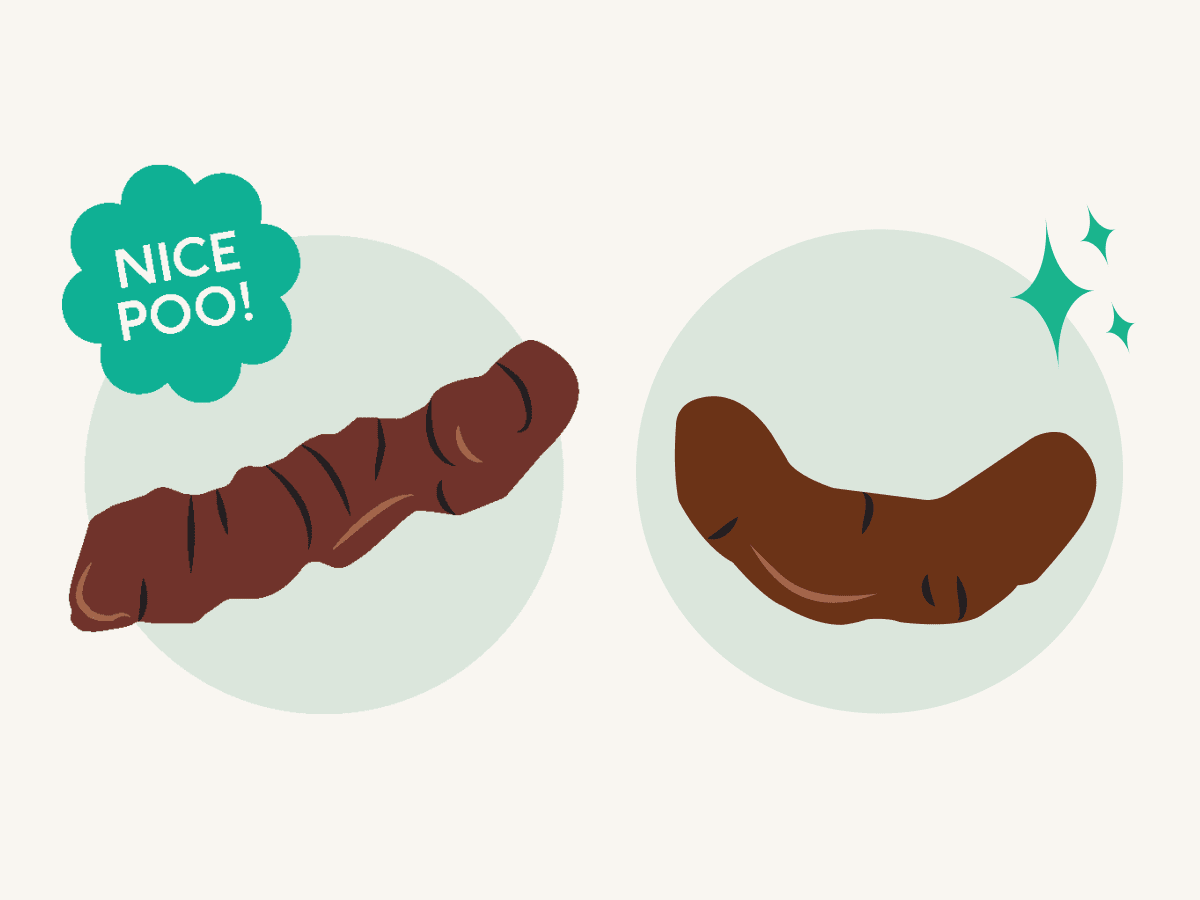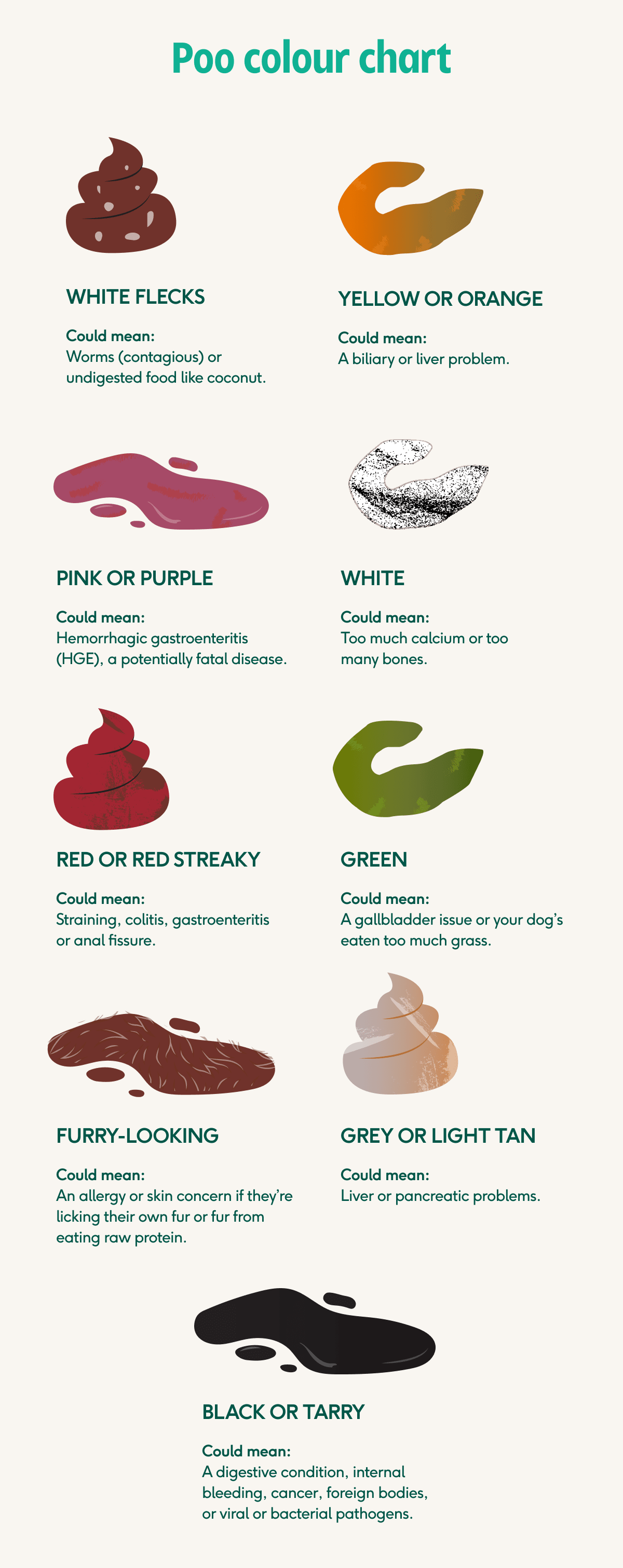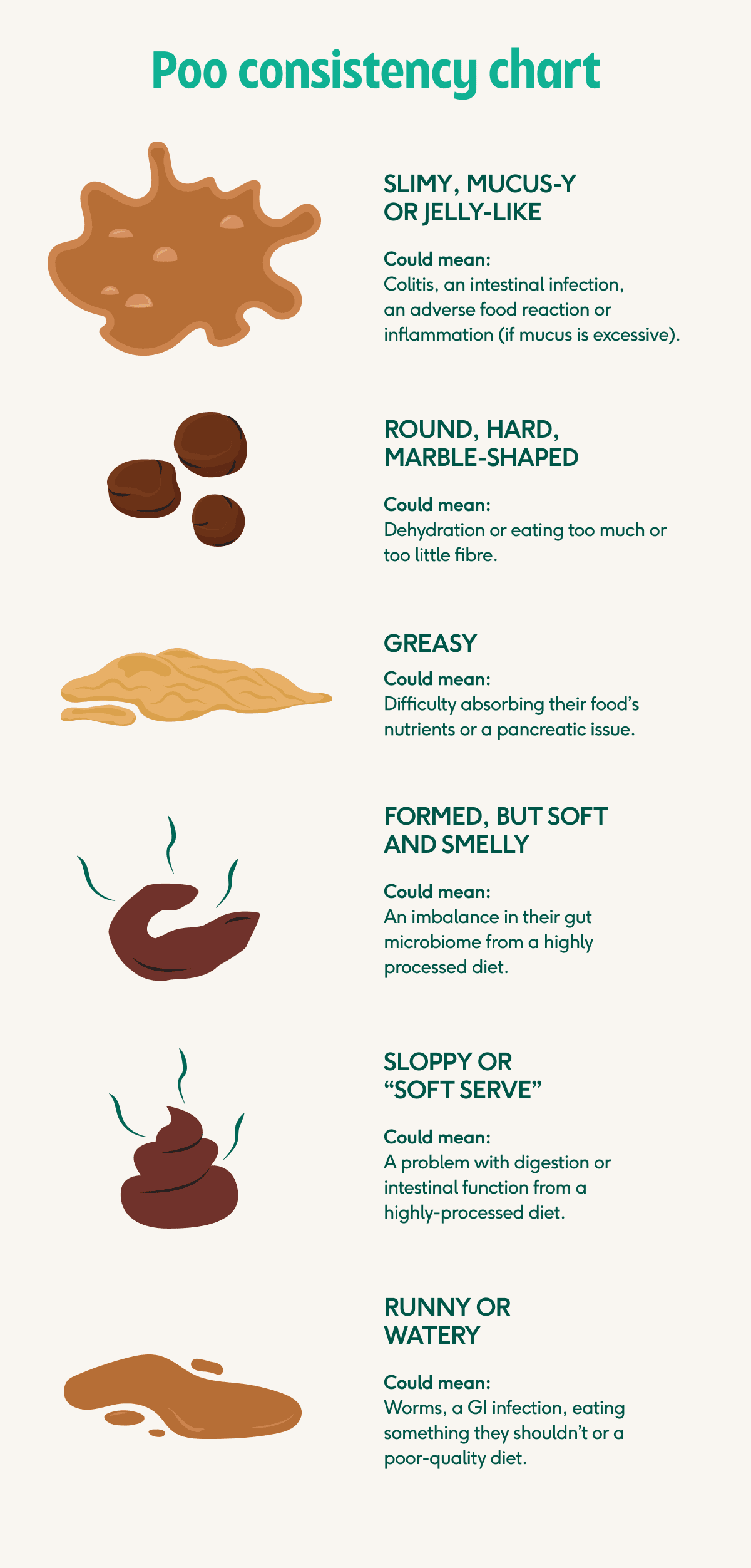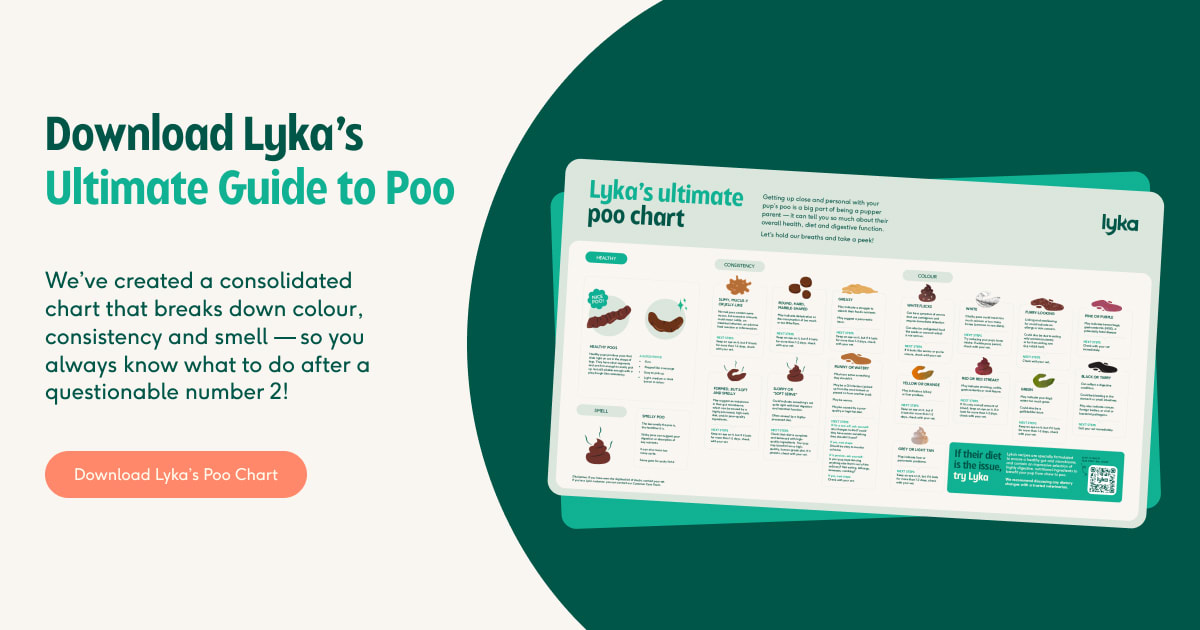From soft and stinky stools to firm and healthy logs, it’s time to get the full scoop on your dog’s poo.
When it comes to poo, what goes in, must come out — whether that’s your pup’s dinner or what they’ve sneakily gobbled from the park. It can also tell us a lot about their health and even indicate red flags that might require a trip to the v-e-t.
Our ultimate guide is backed by Lyka’s in-house veterinary experts and explores the stinky truth about number twos, with helpful dog poo colour and texture charts.
TMI? There’s no such thing when it comes to our dogs — especially when we’re talking about their health.
What does a healthy poo look like?
Healthy dogs produce poos that slide out in the shape of logs and are light-medium to dark brown. They have segments and a playdough-like consistency, and are firm enough to pick up easily without leaving anything behind.
Healthy stools will vary depending on the pup. Understanding your dog’s bowel movements can help you recognise what their “normal” poo looks like so you can tell when something changes.
A one-off change in shape or consistency is usually not a concern. But if your dog’s poo continues to look unusual or they are going to the toilet more or less than usual, speak to your vet, as this may be a sign of a gut health issue.
How does Lyka define a “really good poo”?

At Lyka, a “really good poo” matches the criteria of a healthy poo: they’re light-medium to dark brown logs and easy to scoop.
A Lyka poo is often smaller and less smelly (win!). Lyka’s fresh wholefood recipes are more easily digested and absorbed into the body, producing relatively little waste compared to processed diets.
A closer look: colour
The colour of your dog’s poo can reveal a lot about their health.
A healthy poo will be light-medium or dark brown, but this can be influenced by the food they’ve eaten, so keep this in mind before making a call. Food like seeds or coconut aren’t always digested, so they’ll often be visible in poo and can be easily mistaken for worms.
If the change in colour does not relate to their diet and it’s a persistent change to their normal bowel movements, then it may be a cause for concern. Time to rope in the professionals and get some advice from your vet.

White flecks
White flecks in your dog’s poo can be a sign of worms, which are contagious and require immediate veterinary attention.
If your dog has recently ingested rice, seeds, or coconut, the white specks may be undigested food.
Next steps: Make an appointment with your vet if it looks like worms or you’re unsure, and remember to stay up to date with your pup’s worming treatment.
White poo
If your dog’s poo is white with a chalky consistency, it indicates that there may be too much calcium in their diet or they’ve been eating too many bones, which is common in raw diets.
Next steps: Try reducing your pup’s bone intake and monitor their subsequent bowel movements. If their white poos persist, check with your vet.
Furry-looking stools
Fur in your dog’s poo could be from eating small rodents, or it could be from their raw food, like rabbit fur.
If your dog has been licking themselves a lot recently, they may have swallowed some of their fur which has appeared in their faeces. Their poo isn’t necessarily the concern in this situation, but their constant licking could be a sign of an allergy or a skin disease.
Next steps: Suspected allergies or skin diseases should be investigated by your vet.
For residual fur from something they’ve eaten, it’s normal for it to pass through their system. Continue to observe the frequency of their toilet trips and check the quality of their stools. If you have any concerns, seek veterinary advice.
Grey or light tan poo
If there’s too much fat in your pup’s diet, their system may struggle to digest it all, leading to greasy, grey dog poo. In more serious cases, grey or light tan stools may suggest liver or pancreatic problems.
Next steps: If your dog is otherwise in good health, continue monitoring your dog’s poos for 1-2 days to see if the colour changes to a healthy light-medium to dark brown colour. If not, make an appointment to speak with your vet.
Pink or purple faeces
If you notice an unusual pink or purple colour in your pup’s faeces, it could be a sign of hemorrhagic gastroenteritis (HGE). HGE causes vomiting and diarrhoea and can be fatal in some cases.
Next steps: Call your vet immediately.
Red or red streaky poo
Red faeces, red streaks or bloody mucus in dog poo is often a sign of bleeding in the lower gastrointestinal tract. Your pup might be straining too much, leading to an anal fissure, or it may indicate a gastrointestinal disease such as colitis or gastroenteritis.
Next steps: Blood in your dog’s poo is not a normal occurrence. If there’s only a small amount of blood, keep an eye on it and your pup’s behaviour. If it lasts longer than 1-2 days, visit your vet for advice.
Green poo
Green dog poo usually suggests one of two things: ingesting too much grass or a possible gallbladder issue.
Pups may chew a blade or two of grass now and then, so it’s relatively normal to find grass in your dog’s poo. Sometimes it’s to soothe an upset stomach or to add fibre to their diet. They cannot digest grass effectively, so it ends up in their stools.
Next steps: Contact your vet if there’s no grass in their faeces and their poo remains green for the next 1-2 days.
Yellow or orange poo
If you notice that your dog is producing yellow or orange stools, it might be a sign of a biliary or liver problem. The unusual colour comes from the bile acids in their system.
Next steps: If your dog is otherwise in good health, monitor them and their bowel movements, but if the problem persists for more than 1-2 days, call your vet.
Black or tarry poo
Black, tarry dog poo is not a common occurrence. It’s a digestive condition called melena, which refers to bleeding in the upper gastrointestinal tract, like the stomach or the small intestines. The sticky, black consistency comes from the partially digested blood.
Causes of melena include:
Parasites
Viral or bacterial pathogens
A foreign body in the gastrointestinal tract
Exposure to toxins
Cancer
Next steps: Call your vet immediately.
A closer look: texture and consistency
The texture, consistency, and odour of your dog’s poo can also help clue you into what’s going on with your pup.

Slimy, mucousy or jelly-like poo
Some mucus in dog poo is fairly normal — your pup’s intestines naturally produce mucus to keep their colon’s lining moist and lubricated, preventing constipation.
Excessive amounts of this slimy substance in their stools may suggest:
Colitis
Parasites
An intestinal infection
A rapid change in diet
An adverse food reaction
An inflammatory disorder
Dietary indiscretion (eating unusual items)
Next steps: Keep an eye on the situation, but if it persists for more than 1-2 days, call your vet.
Round, hard, marble-shaped poo
Stools that are dry, hard and sometimes crumbly may be an indication that your dog is constipated. Not fun!
A reduction in intestinal movement can be very uncomfortable and painful for your pup. It can be caused by highly-processed, hard-to-digest foods, including kibble, or a diet that contains too much or too little fibre.
If the stool is quite large compared to the amount of food they’ve consumed, it could imply that the food isn’t being digested properly.
Lyka has a high moisture content, particularly our Chicken and Fish Bowls, which helps with hydration to prevent constipation. The insoluble fibres found in each recipe help to increase stool bulk and stimulate movement within the gastrointestinal tract. We always use healthy fibre sources like ancient grains, purple sweet potato and butternut squash.
Next steps: If the problem continues for more than 1-2 days, make an appointment to see your vet.
Greasy poo
Faeces that look greasy is a sign that your pup is struggling to absorb nutrients from their food and may indicate an issue with their pancreas.
Next steps: Speak to your vet for their professional opinion.
Formed, but soft and smelly poo
A soft and stinky poo or excessive flatulence can be a sign of an imbalance in your pup’s gut health and microbiome. It can be caused by a high-fat or high-carbohydrate diet and poor-quality ingredients that are hard to absorb, resulting in excess fermentation in the colon that generates gas.
Lyka meals contain natural probiotics and prebiotics to help restore the balance of the microbiome to improve overall health and reduce those offensive farts.
Next steps: Check their diet and adjust their fat and carbohydrate ratios under the guidance of your vet or pet nutritionist.
Sloppy or “soft serve” poo
Let’s get one thing straight, soft serve should never come out of your pup. Poo with a soft-serve consistency often indicates something not quite right with your pup’s digestion and intestinal function.
Sloppy stools can be caused by dietary, environmental or health reasons, and can be common in pups that are fed a highly processed diet or food that’s high in refined carbohydrates, such as kibble.
The fresh ingredients in Lyka meals are digested and absorbed easily, leading to smaller, firmer stools. To help your dog form scoopable poos we add dietary fibre, like psyllium seed husk, to most recipes.
Next steps: Consult your vet for a conversation about their poo and gas habits. They’ll be able to rule out any medical conditions and discuss dietary options with you.
Runny or watery poo
Diarrhoea occurs when your pup’s food moves too fast through their digestive tract and doesn’t allow the intestines enough time to absorb the fluids it normally would.
Watery, runny dog poo, can also be caused by a poor-quality or high-fat diet. It can also be a sign of intestinal parasites or worms, so ensure your dog is up to date on their worming treatments.
Next steps: It may be a one-off bout of diarrhoea and your dog needs to pass something out of their system quickly — they should be back to normal relatively soon. Ask yourself: have there been any changes to their diet or did they eat something they shouldn’t have?
If the problem persists, ask yourself: is there anything else out of the ordinary like food refusal, lethargy, lameness or vomiting? If so, it’s time to call your vet.
Smell
Stinky poos are a sign of poor digestion or absorption of key nutrients. The same can be said for awful farts, which can also indicate too many carbohydrates in your dog’s diet — a common problem for dogs on kibble diets. The less smelly your dog’s poo is, the healthier their digestive system is.
Next steps: Speak to your vet about the right diet for your pup.
Poos when transitioning to a new diet
Trying something new? Here’s what you can expect from number twos.
When dogs transition onto a new diet it’s common to experience some changes to your pup’s poo. This is completely normal while your dog’s system is adjusting to different ingredients and developing a strong microbiome to help digest the new food.
The gut microbiome refers to the microorganisms that live in the gastrointestinal tract — the more diverse the microbiome, the better. If your pup’s diet has been limited to one type of food for a long time, their microbiome will be relatively limited. Moving to a fresh food diet, like Lyka, introduces prebiotics and probiotics that boost their gut health.
Some dogs don’t experience any changes to their stools during the transition, but for others, it may take a few days for their stomach to settle (especially if they have a history of tummy troubles). Either way, here are some handy hints for what to look out for.
What’s normal during the transition period
Some changes to the texture, colour and frequency of your dog’s bowel movements may occur during a transition to a new diet. Changes in consistency to looser stools or diarrhoea are the most common.
If there are no other unusual signs and your dog is happy and healthy, there shouldn’t be any cause for concern. Their system should settle down after a few days and their poos should return to normal.
What’s not normal during the transition period?
If the changes to your pup’s poos last longer than a few days or if they seem unwell, this might be a sign to slow down or pause the transition. This can happen if your pup has a sensitive stomach, a history of gastrointestinal issues or if the transition has been too quick.
If you notice any other abnormalities in their stools, speak to your vet for advice.
Next steps: Our Customer Care Team is always available to answer your questions or provide guidance on transitioning to Lyka. If you’re in any doubt at any time, always contact your vet for a consultation.
How a fresh food diet can improve poos and gut health
Lyka’s vet-formulated healthy dog food contains specifically chosen ingredients to nourish your dog from the inside out. Fresh, wholefood nutrients are gently cooked and absorbed more effectively into your dog’s system than high-carbohydrate or highly-processed diets, boosting their health and creating smaller, firmer poos.
Your dog’s microbiome is central to their immune system, hormone regulation and their gut-brain axis. Good guts don’t just improve their poos, they improve their overall health and wellbeing.
Want a copy of our guide to keep with you? We’ve created a consolidated chart that breaks down colour, consistency and smell — so you always know what to do after a questionable number 2!


)
)
)
)








